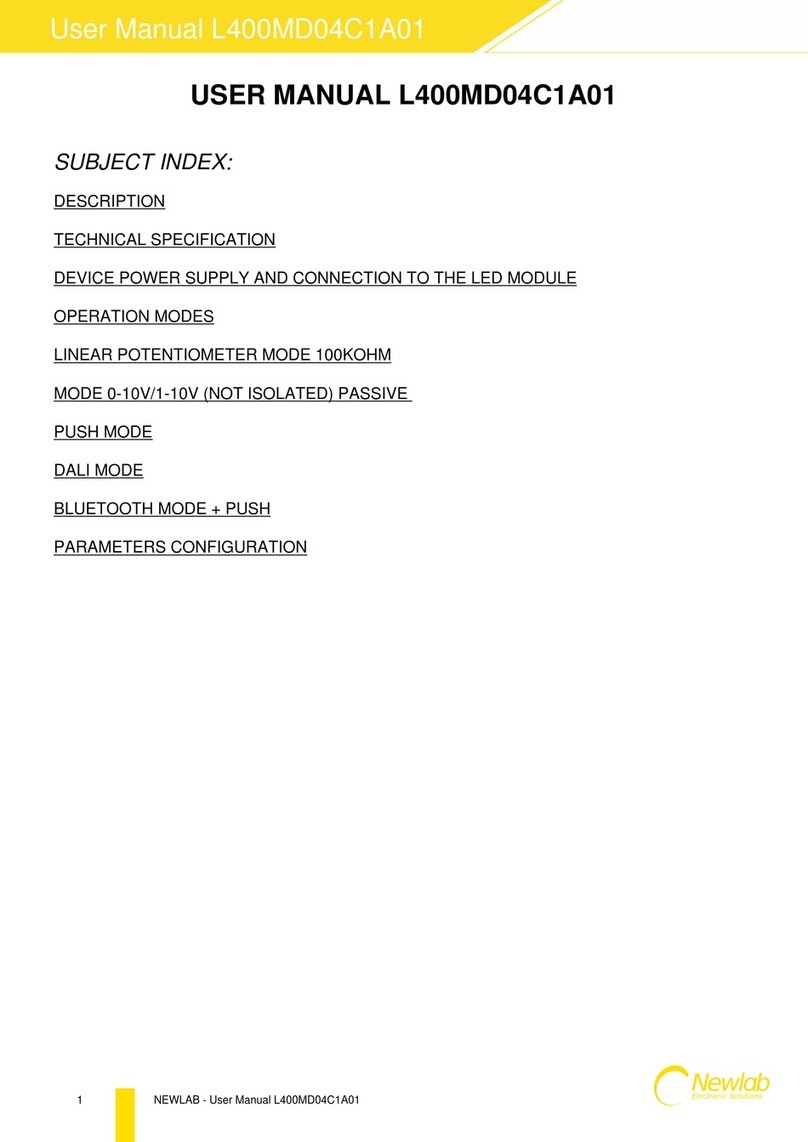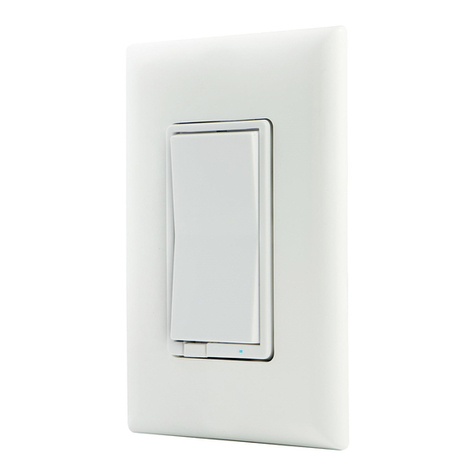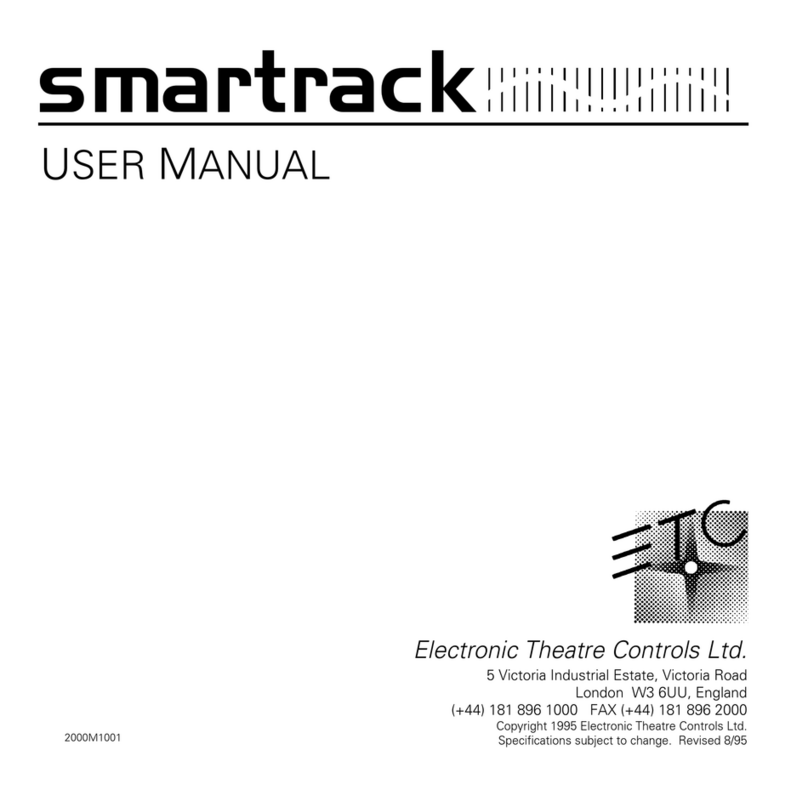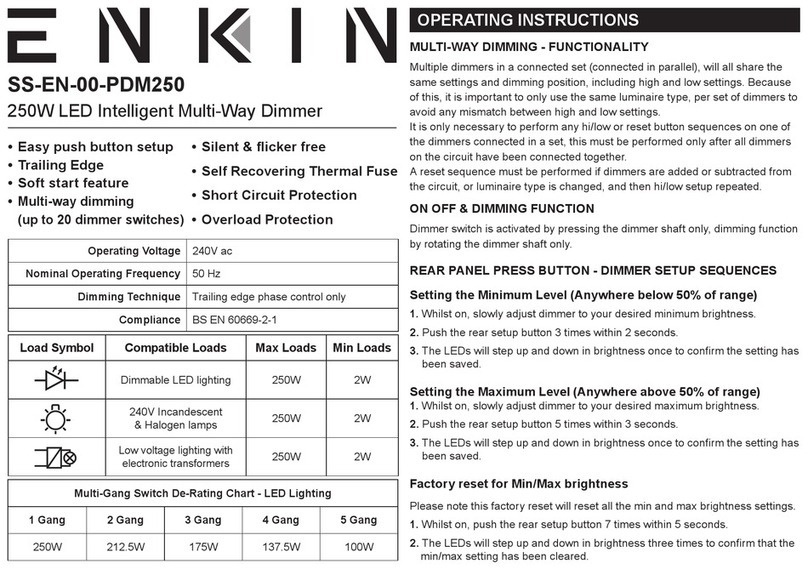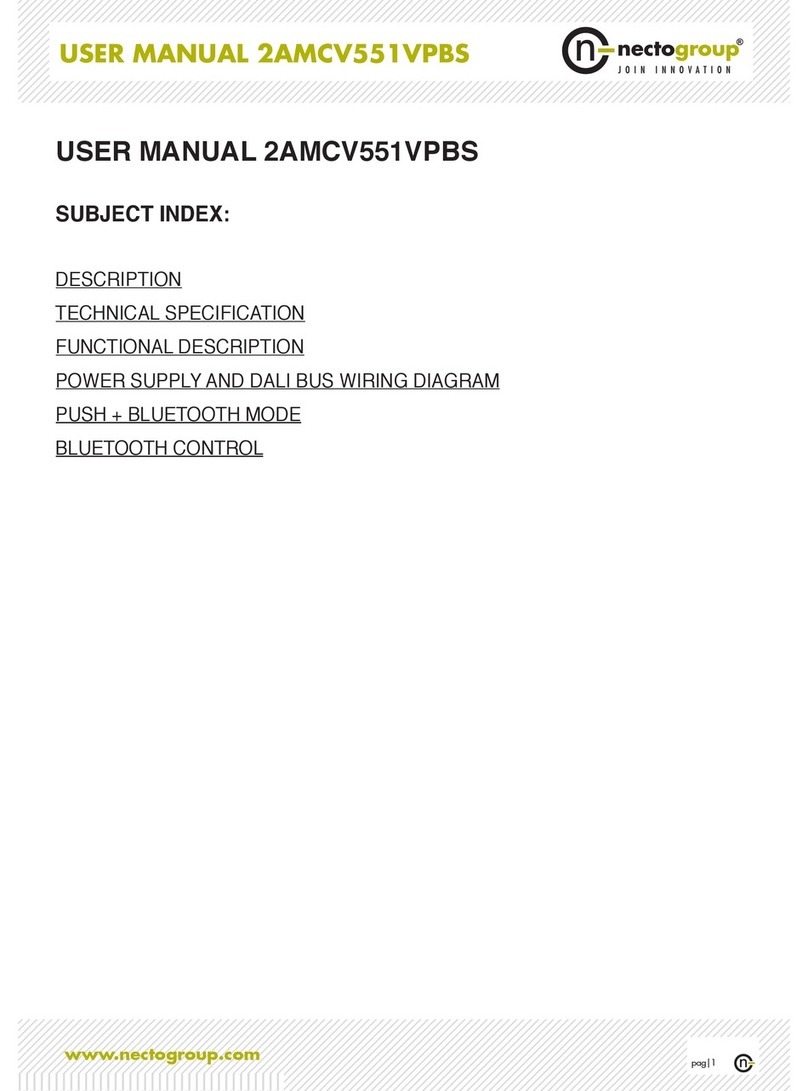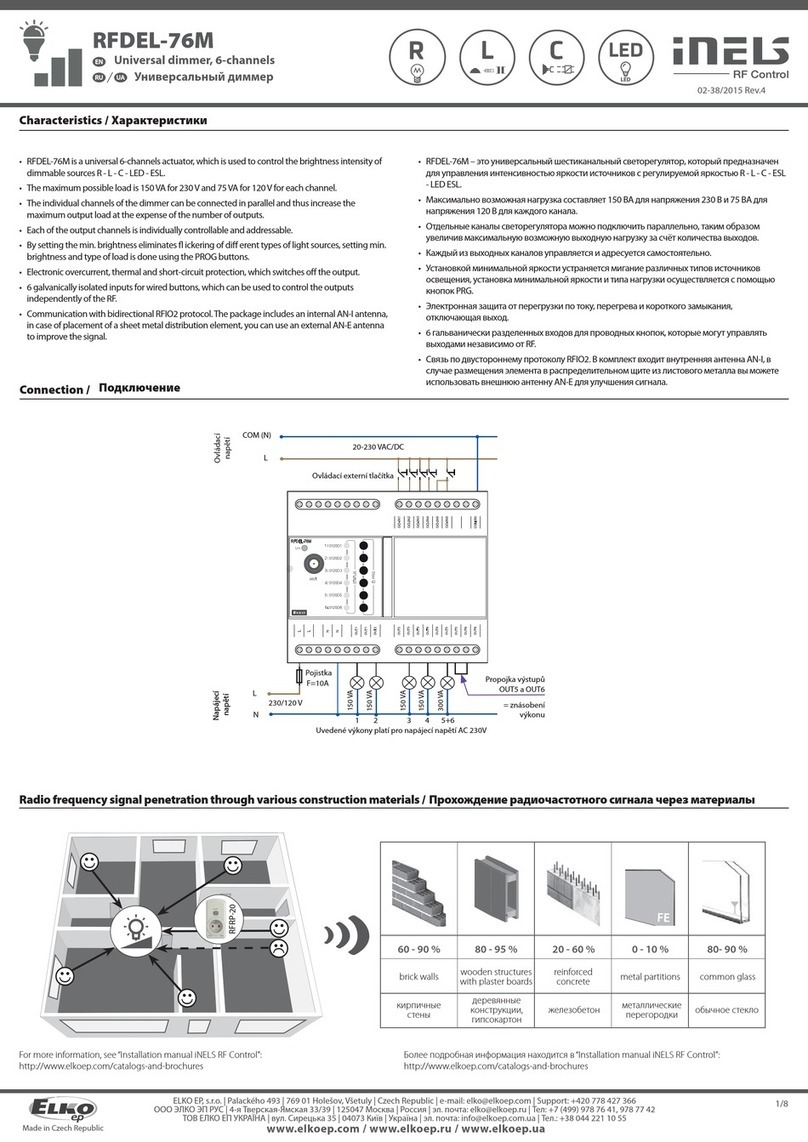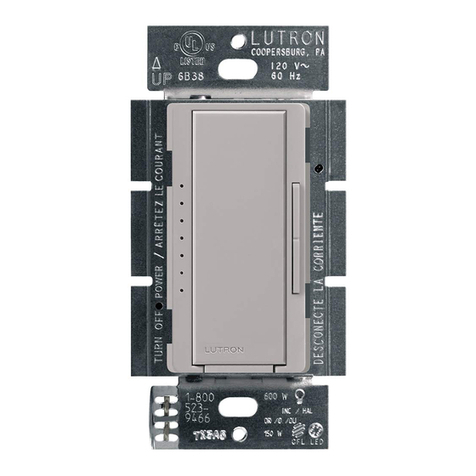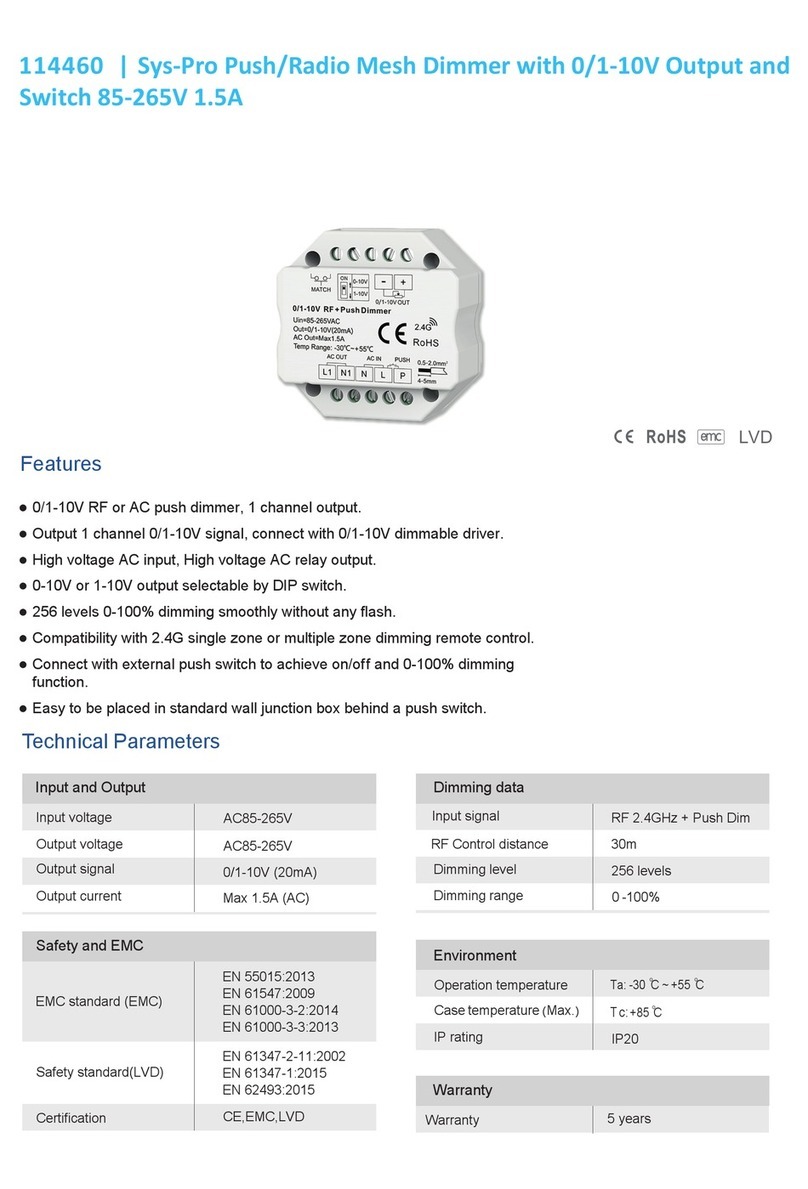esera auto connect 11221 User manual

All rights reserved. Reproduction as well as electronic duplication of this user guide, complete or in part, requires the written consent of
ESERA GmbH. Errors and technical modification subject to change. ESERA GmbH, ESERA-Automation 2020
www.esera.de 11221 V2.0 R1.0 Manual Page 1 von 7
Art. No. 11221
User Guide
1-Wire Dual Dimmer 1
with pushbutton inputs (extension input)
2 channel dimmer with smooth dimmer behavior
max. 460VA/W Power per channel*
2 Pushbutton control (extension input)
2 buttons on top of module
Control inputs for 1-wire bus system
LED display for dimmer values
Phase angle control technology for
Dimmable LED lights
Halogen lamps high voltage 230V
Low-voltage halogen lamps with
wound transformers
light bulbs
DIN rail housing for control cabinet installation
Simple software control
Low space requirement in the control cabinet
Simple assembly
1 Introduction
Before you start with the installation of the Dual Dimmer 1 and put the device into operation, please read these
installation and operating instructions carefully until the end, especially the section of the safety instructions.
2 Product Description
With the Dual Dimmer 1 you can dim and switch lamps very gently.
The brightness of the connected lamps can be controlled or switched on/off by the push-button dimmer function in
the living room (extension input), by push-buttons on the top of the module and electronically via the 1-wire
interface. Any buttons from all switch ranges can be used for the push-button dimmer function. The dimmer
behavior is always very soft and pleasant.
You can change the brightness by pressing the living area buttons for a long time and switch on/off by briefly
pressing the button.
The touch dimmer function works with 12V or 24V DC voltage, which does not give off any disturbance in the
living room. This makes the Dual Dimmer 1 ideal for low-radiation areas such as bedrooms and living rooms.
The ESERA manual control allows you to operate the lighting reliably. Everything functions as in a "normal
house", even without Smart Home control or software.
The 1-Wire Bus interface is available for integration into your Smart Home control system.
* When installed in distribution cabinets with low heat dissipation, e.g. installed in wooden or (RI) plaster walls, the connected
load must be reduced by 25%, also when the ambient temperature rises above 25°C.

All rights reserved. Reproduction as well as electronic duplication of this user guide, complete or in part, requires the written consent of
ESERA GmbH. Errors and technical modification subject to change. ESERA GmbH, ESERA-Automation 2020
www.esera.de 11221 V2.0 R1.0 Manual Page 2 von 7
This dimmer can switch and dim both dimmable LED luminaires, ohmic (e.g. incandescent lamps, HV-halogen)
and inductive (e.g. LV-halogen with transformer or fans) loads with corresponding power. Low-voltage halogen
lamps may only be operated in conjunction with a wound transformer.
For the living room touch dimmer function, it is sufficient to supply the dual dimmer 1 with the 1-wire bus voltage
(12V). This enables a "Smart Home Ready" installation in your building or apartment. This also ensures extremely
high reliability, as the lighting functions when the Smart Home control is not yet programmed or has failed.
3 Auto-E-Connect® Support
The ESERA Auto-E-Connect® 1-Wire Plug and Play system will be used for the
1-Wire Bus supported. This enables fully automatic configurations of 1-Wire sensors
and actuators on the 1-Wire bus. It is optimized for industrial applications and
enables significant added value beyond the sensor and chip data.
The Auto-E-Connect function automatically recognizes ESERA chips, sensors and actuators, starts suitable
libraries and outputs fully formatted data.
The Auto-E-Connect functionality will be available from mid 2020 via 1-Wire Controllers, 1-Wire Gateways and
1-Wire ECO from ESERA available.
Further information on ESERA Auto-E-Connect can be found on the ESERA website, ESERA Config-Tool 3, or in
the download area for this article in the ESERA Webshop.
4 Technical Data
Dimmer channels 2, Phase section Technology
Output: max. 460W / 460VA
When installed in distribution cabinets with low heat dissipation, e.g. installed in wooden
or (RI) plaster walls, the connected load must be reduced by 25%, also when the
ambient temperature rises above 25°C..
Nominal voltage: 230VAC +/-5% 50Hz
Consumers: - Dimmable LED luminaires
- ohmic loads, e.g. incandescent lamps, HV-halogens
- inductive loads, e.g. LV halogen only with wound transformer
or fans up to max. 300W / 300VA
Unsuitable - Fluorescent lamps and energy saving lamps
consumers - Low-voltage halogen lamps with electronic transformers
- PL, SL, DULUX or Biax light sources
Short-circuit protection: Fine fuses (3.15A/M) per output channel, changeable without opening the housing
Data interface: 1-Wire Bus (12V, Data und Masse)
Function Data interface:
1-Wire Module: DS2408 Interface
Operating voltage: 12VDC (+/-10%)
Current consumption: max. 25mA at 12V bus voltage
Button Dimmer: 2 binary DC inputs, electrically isolated
input voltage 10-30VDC, max. 10mA per input, common ground
Function Touch dimmer: Long key press: gentle dimming light/dark
Short keystroke: on/off
The last brightness value is stored permanently. 127 Dimmer steps per channel
Installation: Cable length for push button dimmer max. 100m
Connection: Screw terminals (up to 2.5 square mm cable cross-section)
Note on the detection of suitable and unsuitable transformers
For wound transformers, a commercially available resistance meter (multimeter) can be used to measure the
Transformer resistance (power 20-250W) with less than 50 Ohm between L and N can be measured.
With electronic transformers of comparable power, you can usually achieve resistance values of greater than
Measure 100,000 Ohm between L and N.
These electronic transformers are not suitable for the dual dimmer 1 (phase angle control).
An already wired electronic transformer must always be disconnected from the mains on the 230 V and
low-voltage side. The circuit must be disconnected (see safety instructions).
Make the connection according to one of the following circuit diagrams. The cables to be connected
should be stripped approx. 12 mm.

All rights reserved. Reproduction as well as electronic duplication of this user guide, complete or in part, requires the written consent of
ESERA GmbH. Errors and technical modification subject to change. ESERA GmbH, ESERA-Automation 2020
www.esera.de 11221 V2.0 R1.0 Manual Page 3 von 7
Art. No. 11221
5 Ambient conditions
Temperature, operation 0°C to +40°C,from 25°C the output load must be reduced, see technical data
Air humidity: 10 - 92% (non condensing)
Dimensions: 70 x 90 x 70mm (WxHxD)
Protection class: II
Protection system: IP20
Insulation strength: 500VAC output to 1-Wire Bus, 500VAC push-button interface to 1-Wire Bus
6 Wiring diagram
The connection diagram is available in the shop as a separate document.
Connection topside
14 = Neutral input 230VAC
15 = Input phase 230VAC
19 = Dimmer output 1
18 = Dimmer output 2
Module bottom
Push-button input / manual controll
Control voltage 10-30VDC
1 = GND (ground) Push-button Input
2 = Push-button channel 1, on/off/dimming
3 = Push-button channel 2, on/off/dimming
7 Conformity
EN 50090-2-2,
EN 61000-4-2, ESD
EN 61000-4-3, HF
EN 61000-4-4, Burst
EN 61000-4-5, Surge
EN 61000-6-1, noise immunity
EN 61000-6-3, Interference radiation
RoHS
1-Wire Bus
10 = +12V external voltage (optional)
11 = GND (ground)
12 = 1-Wire data cable
13 = +12V voltage

All rights reserved. Reproduction as well as electronic duplication of this user guide, complete or in part, requires the written consent of
ESERA GmbH. Errors and technical modification subject to change. ESERA GmbH, ESERA-Automation 2020
www.esera.de 11221 V2.0 R1.0 Manual Page 4 von 7
8 Operating mode, display and operation
The Dual Dimmer 1 has two operating modes, normal mode and submenu.
The behavior of the dimmer can be changed via the submenu.
8.1 Normal operation
After commissioning, the device is in normal operation. The two dimmer channels can be controlled via the
buttons on the top of the module, the external binary inputs or via the 1-wire interface.
The current dimmer values are shown on the LED display in 25% steps.
8.2 Submenu for dimmer behavior
If you press both buttons on the top of the module simultaneously for 3 seconds, the module switches to the
submenu where you can change the dimmer behavior.
If the dual dimmer 1 is in this menu, the status LED flashes continuously fast. The selected menu option is
animated by the upper row of LEDs.
If you do not use a button for 3 seconds, the Dual Dimmer 1 automatically switches to normal operation.
Functions of the module buttons in the submenu
Button 1: Select mode (currently the Dual Dimmer 1 has two modes to choose from)
Button 2: Mode on/off.
Mode 1 (LED 25%): dimmer on/off hard or soft
Mode 1 can be used to select how the dimmer behavior is to behave on a short keystroke (output on/off).
You can choose between soft and hard.
Mode 2 (LED 50%): dimmer on/off, 0/100% or 0/last dimmer value
Mode 2 can be used to select whether the dimmer value changes to 100% or to the last stored value after
briefly pressing the button.
9 Brightness control Dimmer
The dimmer channels can be controlled directly via the two buttons on the top of the module.
With a short push of a button the corresponding output is switched on or off.
A long press of the button makes the brightness brighter or darker.
The current dimmer value is shown on the LED display on the top of the module in 25% steps.
For further details on the ESERA-Automation lighting system, please refer to the web page
https://www.esera.de/smart-home/anwendungsbeispiele/lichtsteuerung/
Display
Designation
Function LED
LED 1-8
Output 1-8
- LED upper row
Dimmer value in 25% steps Channel 1
- LED upper row
Dimmer value in 25% steps Channel 2
LED PWR
Power
- LED- power indicator
LED Status
Status display
- LED lights up for 2 seconds to start the system
- Flashing with new dimmer values
Pushbutton
Designation
Function Pushbutton
Channel 1
Up/Down
Dimmer 1
on/off diming
- Control Dimmer 1:
Short press on/off, long press Dimmer brighter/darker
- Submenu Selection of the dimmer function
Channel 2
Up/Down
Dimmer 1
on/off diming
- Control Dimmer 2:
Short press on/off, long press Dimmer brighter/darker
- Submenu Function selection

All rights reserved. Reproduction as well as electronic duplication of this user guide, complete or in part, requires the written consent of
ESERA GmbH. Errors and technical modification subject to change. ESERA GmbH, ESERA-Automation 2020
www.esera.de 11221 V2.0 R1.0 Manual Page 5 von 7
Art. No. 11221
10 Pushbutton interface
In addition to the manual control (module top) and the 1-wire interface, the Dual Dimmer 1 also has an 8-fold
pushbutton interface (8 x binary input) for switching and dimming the outputs.
To switch an output, a short input signal (keystroke) is sufficient, to dim a long input signal to the corresponding
input.
The inputs of the 8-fold pushbutton interface (extension inputs) are intended for switching and dimming luminaires
or luminaire groups in commercial and residential areas. The inputs are controlled with a typical 24V (10-30V) DC
voltage. Pushbuttons from any switch manufacturer can be used on the inputs. Any number of push-buttons can
be connected in parallel at each input of the push-button interface.
The direct control of the Dual Dimmer 1 via pushbutton interface ensures very fast switching and dimming
even without a Smart Home System (software).
In addition to pushbuttons, another pulse control signal can also be used to switch and dim the outputs of the
Dual Dimmer 1.
All three interfaces, module push-button, pushbutton interface and 1-wire interface, work in parallel on the
outputs. An output switched e.g. by the 1-Wire interface can be switched off or on and dimmed manually or via
pushbutton interface.
11 Software / Control
The 1-Wire interface of the Dual Dimmer 1 is controlled by standard commands for the DS2408 module.
The 1-Wire interface can be used to read back every keystroke as well as the dimmer values of the outputs. The
dimmer values are output alternately via the 1-wire interface. Channel 2 can be detected by bit 5 (1).
The outputs of the dual dimmer 1 are controlled as follows via the 1-wire interface by byte command:
One output can be controlled per transmitted byte value.
- Bits 0-4 corresponds to the brightness value (32 dimmer levels)
- Bit 5 is reserved, currently no function
- Bit 6 is intended for the selection of the dimmer output.
Channel 1 is addressed with a 0, channel 2 with a 1.
- Bit 7 is reserved, currently no function
11.1 Control via 1-Wire Controller / 1-Wire Gateway
The control and data output of the Dual Dimmer 1 is very simplified via the 1-Wire Controller / 1-Wire Gateway.
The current dimmer values and the status of the push-button interface are output continuously.
In the case of a control signal on the push-button interface or on the top of the module, a separate data record
with the normal formatting is output. The following control command can be used to control the dimmer value of
one output at a time. There are 32 dimmer values available per output.
11.2 Control Command for Dual Dimmer 1
One output of the Dual Dimmer 1 is controlled per command. To control the dimmer outputs, the following options
are available
32 dimmer stages (0-31) per channel available.
Command: SET,OWD,DIM,OWD-number, output, dimmer value
Example: set,owd,dim,2,1,25 => OWD number 2, output 1 is set to dimmer value 25.
After controlling the dimmer, the new dimmer value is output as confirmation.
11.3 Data Output 1-Wire Controller / 1-Wire Gateway
For the Dual Dimmer 1 the following data for push-button interface and outputs are output.
The input and output values are output as decimal values 0-254 and in a second data set binary with 0 and 1.
Each input and output has a value which is summed up.

All rights reserved. Reproduction as well as electronic duplication of this user guide, complete or in part, requires the written consent of
ESERA GmbH. Errors and technical modification subject to change. ESERA GmbH, ESERA-Automation 2020
www.esera.de 11221 V2.0 R1.0 Manual Page 6 von 7
Pushbutton interface input:
Button interface channel 1 = 1, button interface channel 2 = 2, module button channel 1 = 4, module button
channel 2 = 8, value 16 - 128 no function (always 0)
Dimmer output:
Output 1 = 1, output 2 = 2, output 3 = 4, output 4 = 8, output 5 = 16, output 6 = 32,
Output 7 = 64, output 8 = 128.
Data output:
1_OWD1_1|1 => Controller No._Module No._Data set | Decimal value Input
1_OWD1_2|10000001 => Controller No._Module No._Data set | Binary representation Input
1_OWD1_3|16 => Controller No._Module No._Data set | Dimmer value channel 1 stage 16
1_OWD1_4|28 => Controller No._Module No._Data set | Dimmer value channel 2 stage 28
Further information on the possibilities and commands can be found in the current documentation
1-Wire Controller /1-Wire Gateway.
12 Operating conditions
The module may only be operated at the voltages, ambient conditions and temperatures specified
and consumers. The operating position of the device is preferably vertical.
The device is intended for use in dry and dust-free rooms.
If condensation water forms, wait for at least 2 hours to acclimatize.
Assemblies and components must not be handled by children!
The modules may only be put into operation under the supervision of a qualified electrician.
In commercial facilities the accident prevention regulations of the association of the commercial trade
associations for electrical systems and equipment must be observed.
Do not operate the module in an environment in which flammable gases, vapors or dusts are present or could be
present.
13 Assembly
The installation site must be protected from moisture. The device may only be used in dry indoor areas in
protected outdoor areas.
The device is intended for installation inside a control cabinet as a stationary device.
14 Disposal instructions
Do not dispose of the device in domestic waste! Electronic devices are to be disposed of
according to the Directive on waste electrical and electronic equipment (WEEE) on local
authorities and collection points for waste electronic equipment!
15 Safety instructions
When using products that come into contact with electrical voltage, the valid VDE regulations must be
observed, especially VDE 0100, VDE 0550/0551, VDE 0700, VDE 0711 and VDE 0860
All final or wiring work must be carried out with the power turned off.
Before opening the device, always unplug or make sure that the unit is disconnected from the mains.
Components, modules or devices may only be put into service if they are mounted in a contact proof housing.
During installation they must not have power applied.
Tools may only be used on devices, components or assemblies when it is certain that the devices are disconnected
from the power supply and electrical charges stored in the components inside the device have been discharged.
Live cables or wires to which the device or an assembly is connected, must always be tested for insulation faults or
breaks.
If an error is detected in the supply line, the device must be immediately taken out of operation until the faulty cable
has been replaced.
When using components or modules it is absolutely necessary to comply with the requirements set out in the
accompanying description specifications for electrical quantities.
If the available description is not clear to the non-commercial end-user what the applicable electrical characteristics
for a part or assembly are, how to connect an external circuit, which external components or additional devices can
be connected or which values these external components may have, a qualified electrician must be consulted.
It must be examined generally before the commissioning of a device, whether this device or module is basically
suitable for the application in which it is to be used.
In case of doubt, consultation with experts or the manufacturer of the components used is absolutely necessary.
For operational and connection errors outside of our control, we assume no liability of any kind for any resulting
damage.

All rights reserved. Reproduction as well as electronic duplication of this user guide, complete or in part, requires the written consent of
ESERA GmbH. Errors and technical modification subject to change. ESERA GmbH, ESERA-Automation 2020
www.esera.de 11221 V2.0 R1.0 Manual Page 7 von 7
Art. No. 11221
Kits should be returned without their housing when not functional with an exact error description and the
accompanying instructions. Without an error description it is not possible to repair. For time-consuming assembly or
disassembly of cases charges will be invoiced.
During installation and handling of components which later have mains potential on their parts, the relevant VDE
regulations must be observed.
Devices that are to be operated at a voltage greater than 35 VDC / 12mA, may only be connected by a qualified
electrician and put into operation.
Commissioning may only be realized if the circuit is built into a contact proof housing.
If measurements with an open housing are unavoidable, for safety reasons an isolating transformer must be
installed upstream or a suitable power supply can be used.
After installing the required tests according to DGUV / regulation 3 (German statutory accident insurance,
https://en.wikipedia.org/wiki/German_Statutory_Accident_Insurance) must be carried out.
16 Warranty
ESERA GmbH guarantees that the goods sold at the time of transfer of risk to be free from material and workmanship
defects and have the contractually assured characteristics. The statutory warranty period of two years begins from date of
invoice. The warranty does not extend to the normal operational wear and normal wear and tear. Customer claims for
damages, for example, for non-performance, fault in contracting, breach of secondary contractual obligations,
consequential damages, damages resulting from unauthorized usage and other legal grounds are excluded. Excepting to
this, ESERA GmbH accepts liability for the absence of a guaranteed quality resulting from intent or gross negligence.
Claims made under the Product Liability Act are not affected.
If defects occur for which the ESERA GmbH is responsible, and in the case of replacement goods, the replacement is
faulty, the buyer has the right to have the original purchase price refunded or a reduction of the purchase price.
ESERA GmbH accepts liability neither for the constant and uninterrupted availability of the ESERA GmbH or for technical
or electronic errors in the online offer.
We are constantly developing our products further and reserve the right to make changes and improvements to any of the
products described in this documentation without prior notice. Should you require documents or information on older
17 Trademarks
All mentioned designations, logos, names and trademarks (including those which are not explicitly marked) are
trademarks, registered trademarks or other copyright or trademarks or titles or legally protected designations of their
respective owners and are hereby expressly recognized as such by us. The mention of these designations, logos, names
and trademarks is made for identification purposes only and does not represent a claim of any kind on the part of ESERA
GmbH on these designations, logos, names and trademarks. Moreover, from their appearance on ESERA GmbH
webpages it cannot be concluded that designations, logos, names and trademarks are free of commercial property rights.
ESERA and Auto-E-Connect are registered trademarks of ESERA GmbH.
18 Contact
ESERA GmbH
Adelindastrasse 20
87600 Kaufbeuren
GERMANY
Tel.: +49 8341 999 80-0
Fax: +49 8341 999 80-10
www.esera.de
WEEE-Number: DE30249510
Table of contents
Popular Dimmer manuals by other brands

Unex
Unex 25716-008-89 operating manual
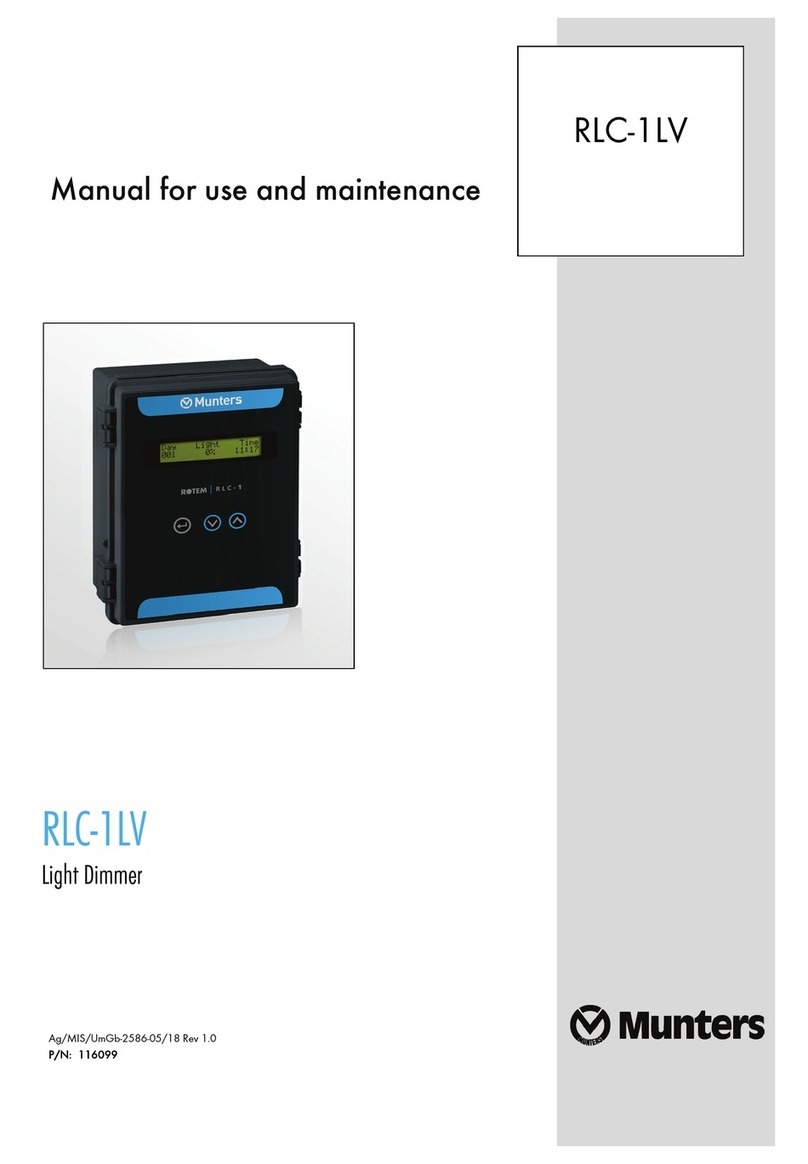
Munters
Munters RLC-1LV Manual for use and maintenance

elsner elektronik
elsner elektronik RF-L UN-ST Technical specifications and installation instructions
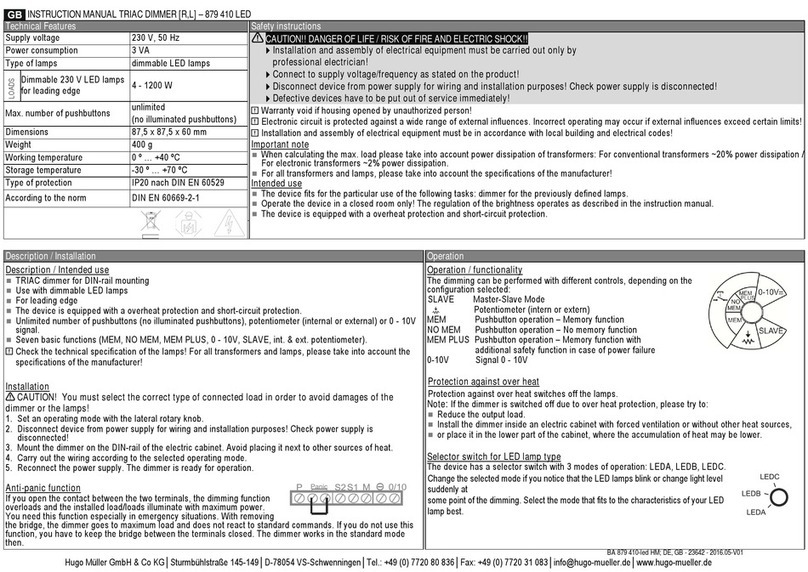
Hugo Müller
Hugo Müller 879 410 LED instruction manual

Sygonix
Sygonix 2887783 operating instructions
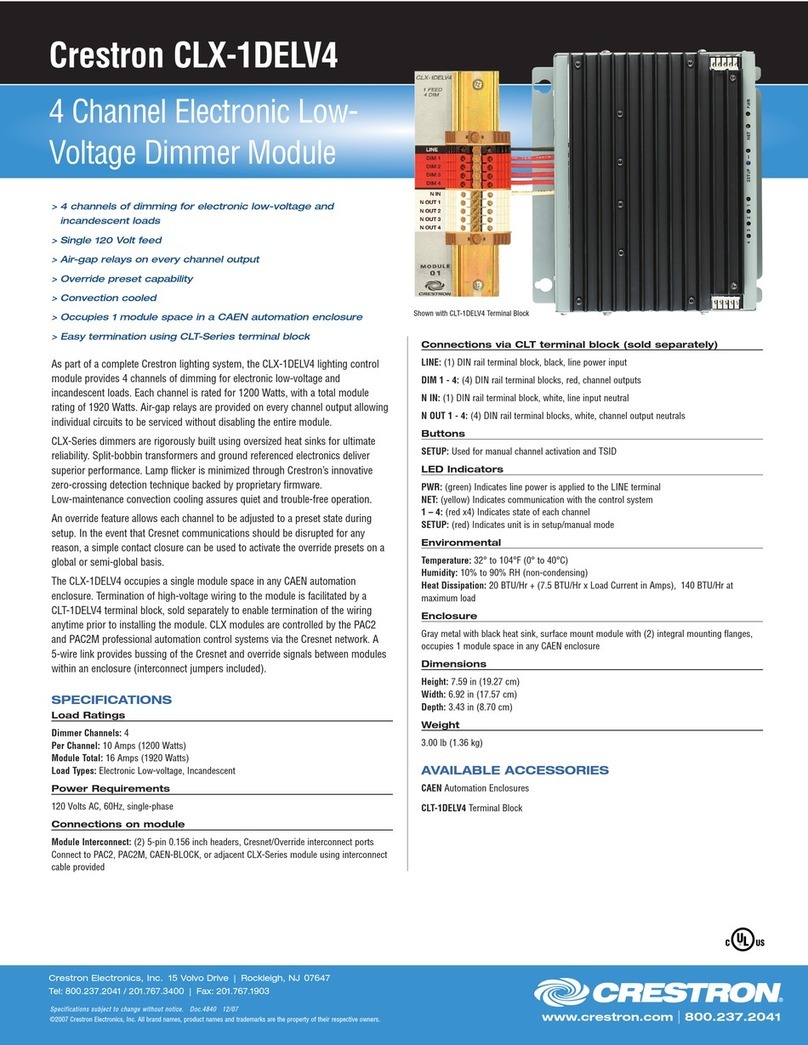
Crestron
Crestron CLX-1DELV4 Specification sheet

